Breeding
The Sagaday pedigree is a true genetic pearl and a combination of breeding trends from all over the important Akhal-Teke world. It combines the ideas of the most outstanding specialist, breeder and guardian angel of this breed – Vladimir Shamborant, the founder of the Tersk stud farm, the intuition and knowledge of Alexander Klimuk, the head of the Stavropol Horse Trade Union, and the legacy of legendary stud farms – Komsomol in Turkmenistan and Lugovska in Kazakhstan, which were the cradle of such icons as Polotli and the Olympian Absent.
Our hero's family tree is based on the male line of the stallion Sere, and its roots date back to 1860 and lead to the stallion Lelyaning Chepi, who was the progenitor of the "father of the breed" - the famous Boinou. The Sere line was separated in 1993, and its founder was born in 1965 in one of the Turkmen collective farms as the son of the stallion Synok and the mare Enysh. His pedigree for five generations back does not bear a trace of inbreeding, which was rare at that time in such a limited gene pool of the breed. The stallion was purchased by Vladimir Shamborant in Ashgabat to be used as a stud at the stud farm in Dagestan, which became the new home for the Akhal-Teke horses from Tersk when it became necessary to move the breeding to another location.

Sere (Sinok - Einysh/Karamatal)
It was impossible to pass by Sere indifferently – he looked like a statue – he was tall, typical, handsome, his deer-like coat with a metallic sheen made him shine like pure gold. This was appreciated in 1978, when he became a champion at the famous Exhibition of Achievements of the National Economy of the USSR. He also impressed with his courage – he raced on the Ashgabat track for three seasons, starting 28 times, of which all starts were victories or paid places. After being brought to Russia, his first foals were born in 1974, and for the last two years of his life he was covered in the Stavropol Horse Breeding Station, where he died in 1984. He left behind a collection of wonderful daughters who became valuable mothers and forever entered the history of the breed. It is enough to mention:
- Azizim – the granddam of the studs: Ardjan (Breed Champion at the Equiros exhibition) and Arzgir (Russian Junior Vice Champion, Russian Champion)
- Derni – the dam of the phenomenal Djugba (Oaksist, 2nd place in the Derby, Pel Award, Karali, Gezel), whose blood still flows in the Stavropol Horse Race
- Feya II – the dam of Aykhanum, who founded her own dynasty at the Shael stud farm, and Fonemy, who gave birth to the dazzling stud Feisal (Russian Junior Champion, World Junior Vice Champion, Russian Vice Champion, World Vice Champion)
- Gvozdika – granddam of the excellent Gazyr Shael, World Champion and sire of such great names as: Gaon Shael, Duag Shael, Djennet Shael and Kheva Shael (the latter two shared the highest podium places in the yearling fillies category at the World Championship)
- Yakhti – progenitor of Yasielda (stud dam in the Stavropol Horse Race, World Youth Champion) and the breathtaking Yazaidym
(World Reserve Champion, World Champion)
- Pariza – one of the most important, classic races for mares bears her name, and she distinguished herself in the breeding arena by giving birth to wonderful mothers: Pampa (mother of Gayaza, Pekhimdar, Pirakhmed, Primula, Prokhlady), Pinega (mother of Pendjire – World Junior Champion, World Champion), Pudokkhan (mother of the legendary Piaster and Khanbegler) and Pion (a stud in Kazakhstan who started in 28 races, winning 22 of them)
Sere also left a very interesting line of sons, such as: Anchar, Chakan, Koldun and Serasker. The most interesting of his male descendants is undoubtedly the last one, who was born in the spring of 1985, a year after the death of his father.
Serasker's mother was Sayat, born in Tersk, a daughter of the grey Karakir and a granddaughter of Gelishikli on the female side. A representative of the Ak Sakal line - Karakir, who, like a grey horse, was black after birth, did not change colour for a long time and for this reason was called Karakunon ("black foal"). Born in 1948 near Ashgabat, he was a horse of exceptional beauty, with a correct conformation, a beautiful, typical, slightly hump-nosed head and very good results on the track. For a long time, he held the record for 1200 metres - 1:19.5. He also had a very interesting, although controversial pedigree due to the fact that a very close inbreeding was used in it. Both Karakir's father and mother came from the same sire - the aforementioned Ak Sakal. It is worth adding that this is one of the few male lines in the breed that are free from Boinou blood. Vladimir Shamborant chose him in Turkmenistan and brought him to Tersk in 1966, so already at an advanced age. Despite this, he managed to obtain a group of offspring before his death in 1974. Thanks to this, as well as Alexander Klimuk's inventiveness, his grandson appeared in the world, who also clearly marked his presence on the breeding scene.
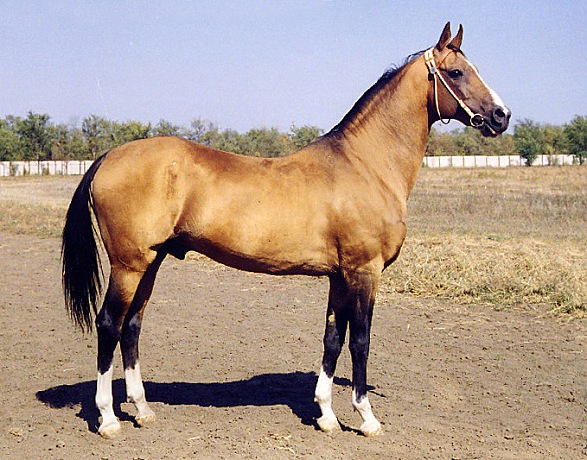
Serasker (Sere - Sayat/Karakir)
Born in the Stavropol Stud Farm, buckskin-colored, with an irregular blaze on his head and painted on all fours, Serasker stood out for his height (164 cm at the withers), solid build and masculine type. Looking at him, you knew right away that you were dealing with a stallion. As a two-year-old, he was sent to Tbilisi for racing training and spent two seasons on the local track.
He took part in nine races in total, winning once, coming second twice and finishing third five times. At that time, the famous Turkmen stud farm Komsomol became interested in young Serasker and it was there that he began his breeding career. He spent two years in Ashgabat, but his name became famous only when he returned to Russia and began breeding at his mother stud farm, where he spent the rest of his life. Serasker's legacy is secured thanks to several of his sons, recognized for breeding, and a large group of mother mares, scattered all over the world - their blood, apart from Russia, also flows in the Czech Republic, Ukraine, France, the Netherlands, Uzbekistan, Kazakhstan and the USA. Serasker's presence is also present in Poland - in 2010, the Stavropol-bred Melesugun was imported to our country, which gave a pair of offspring - the colt Miyan and the filly Mahvash, who may become a mother herself in the near future. The most distinguished Serasker daughters were in particular:
- the well-running Desse, mother of several broodmares and the sire Dagomys, who won the Derby and strongly passed on racing talents to his offspring
- Gissa, who has had numerous show successes at the Russian and World Championships, the dam of Gergebil (Russian Youth Champion, World Vice Champion) who was bred in Kazakhstan, as well as the incredibly beautiful and highly rated at shows, and currently proven dams Gaiba and Gigena
- Russian Youth Champion and Russian Vice Champion Magistral, the dam of one of the most beautiful mares in Alexander Klimuk's collection - Garaay, and the granddam of Motivator, who was imported to Poland from Russia
- Pasta - a long-time stud dam for the Djaparov brothers, the granddam of such titled horses as Khava, the Oaksist, Mugazhir, the Russian Champion, and Djasil, who had a double success in the Derby - second place in Krasnodar and third in Pyatigorsk
- Pustyniya, the dam of the sire Pergenbek, who was fourth at the Russian Championships in both the youth and senior categories, and then covered in Russia and Kazakhstan
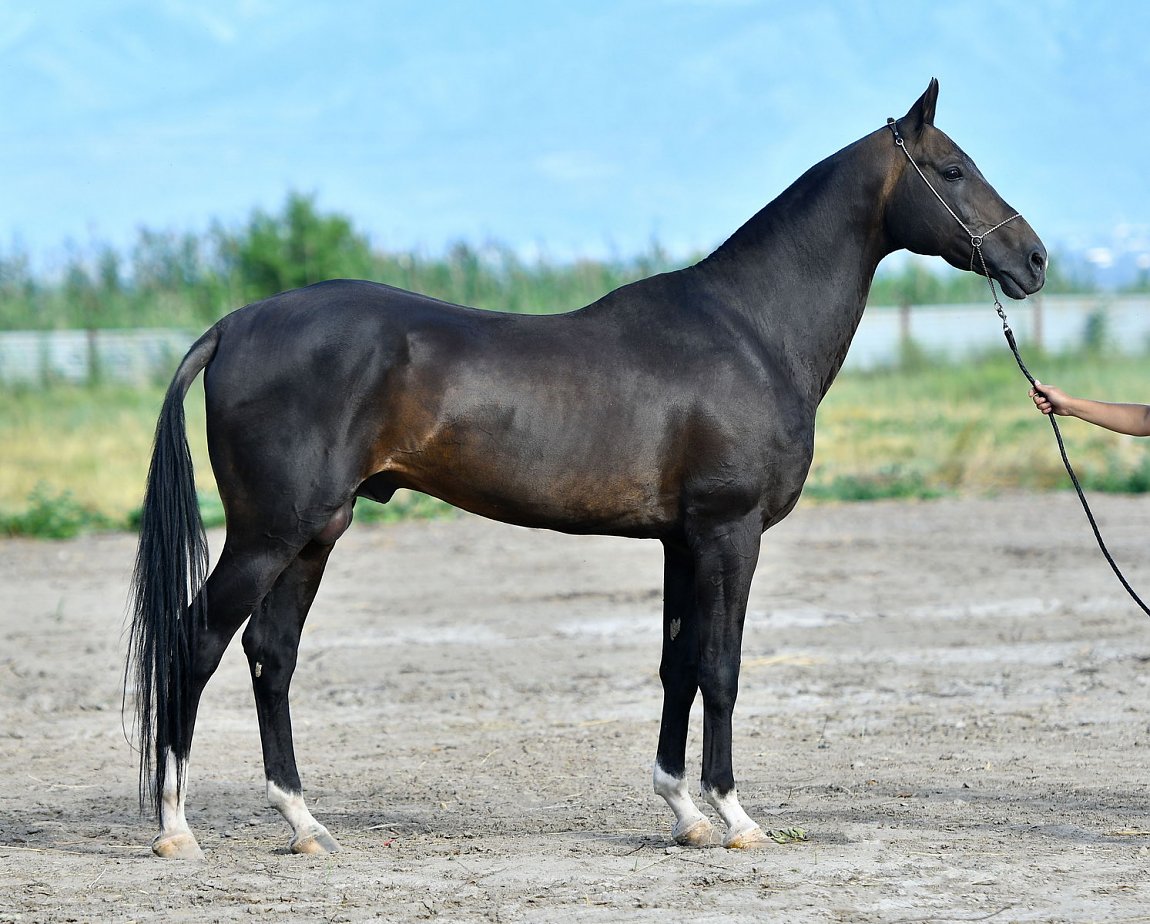
Oraz-Polot (Serasker - Ogledje/Djeikhun)
Among Serasker's sons, the star of his father Sagday, Oraz Polot, shines brightest. This stallion comes from the last year of Serasker, was born in 2006 in the Stavropol Horse Farm and has an excellent pedigree. His mother is one of the few daughters and offspring in general, the Turkmen stallion Djeikhun, who has an interesting, bittersweet story associated with him, and whose hero was also the legendary Gaigysyz. Both were brought to Russia from the Komsomol stud farm in late 1991 by Valeriy Potokin, a stuntman associated with horses who intended to breed Akhal-Teke horses. A few months before that, he had selected and signed a contract for several horses that were to come to his country. Although the horses were paid for almost immediately, the stud farm allegedly claimed that no money had yet been received, and without it, it would not release the purchased horses. It was only after many weeks that the owner received information that the payment had been received and that the horses should be collected quickly. A few days after his arrival, he was met with a shocking situation, because he was informed that his horses had been sold to someone else. He was offered to choose others, but the offer did not seem too tempting. Potokin was devastated by the condition and quality of the horses presented to him. In the end, he decided on two stallions that he liked the most.
One of them was Gaigysyz, who had achieved nothing on the racetrack, and for the Turkmen the horse's performance was a measure of its value. In addition, he was poor and undergrown, probably due to insufficient care and feeding. The second turned out to be Djeikhun.
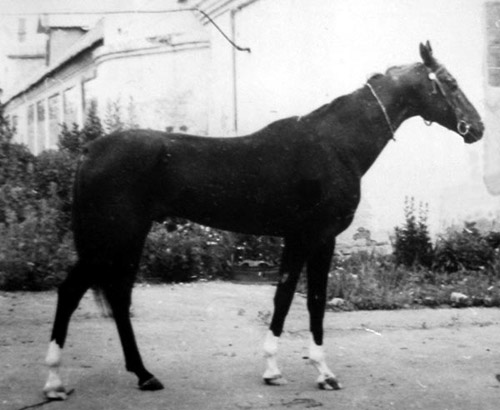
Djekhun (Diagitaj - Zindjir/Senegat)
Despite the fact that the horse was in terrible condition, emaciated, with a balding tail and a terrible disposition, which most likely resulted from the fact that the stallion was standing in isolation. The stable staff were afraid to approach him, and out of nervousness he dug a deep hole in the stable floor. Potokin noticed something special in him, however. The stallion looked like a creature from a fairy tale, he was tall, slender, on a long leg, he had "a lot of air under his belly". His neck was long, beautifully profiled, and on it was set a typical, noble head with "dragon eyes". Djeikhun passed on many of his characteristic features to his offspring, but his influence is also clearly visible in subsequent generations, including in Sagaday himself. When the stallion reached Russia, the owner took proper care of him, the horse took on a healthy shape, his tail grew back, and patience, calmness and attention paid to him made him a normal horse in the yard. The first foals were born in 1993 and 1994 at Potokin's, and the effects were surprisingly good. This made Alexandr Klimuk interested in him and brought him to the Stavropol Horse Factory. He stayed there for one season and left behind a dozen or so foals. Most of them went to breeding and stood out for their beauty, breed type and correct exterior.
Djeikhun's most valuable descendants turned out to be his two Stavropol daughters – the grey Prokhlada, winner of the Oaks and the double Russian Champion, and Ogledje, a mare of refined beauty and type, a copy of her father.

Ogledje (Djekhun - Oprava/Pudok)
Her great-grandmother was the phenomenal Oktava (Khorgos - Ovgan), who founded her own dynasty in the Stavropol Horse Race and named one of the most important races for mares in Pyatigorsk after her. She distinguished herself in breeding by giving birth to phenomenal sons: Omar, Orlan and Yakor, as well as Orkhideya - the mother of such valuable horses as: Gecheli, Pikirli and Oprava. The latter, mated with Djeikhun, gave birth to Ogledje, but in addition to her, also the sire Karaoglan (Russian Vice Champion) and the iconic Garayusup (Youth World Champion, Russian Champion, World Vice Champion). Against the background of so many successes, Ogledje's breeding achievements are also excellent, placing her in the forefront of the most valuable dams in the history of the Stavropol Horse Race. She gave birth to a dozen or so foals, and among them the most noticeable horses in the breed were:
- Kichitorgai – Oaks winner and winner of classic named races for mares
- Oinavach – long-time broodmare for Alexander Klimuk
- Osanka – mother of the stallion Obereg (16 starts, 14 wins), mare Osnova (Youth Champion of Russia, winner of the Pazilla, Oktava, M. Cherkezovey Stakes, second place in the Pel Stakes), filly Ovodan Kala (revelation of the 2024 racing season, 5 starts, 3 wins)
- Ovgankala – mother of Derby winner Orkhon
- Ogulgerek – second place in the Oaks, winner of the Parizy Stakes
- Orazserdar – Russian Champion, sold for an astronomical sum to Chin, father of Russian Reserve Champion Gakia and young mothers Abissinia and Patritsia
To this extraordinary collection of Ogledje's descendants, we should of course add and develop the figure of the magnificent Oraz Polot, father of Sagaday, mentioned a dozen or so paragraphs above. Darkbuckskin-colored, tall, masculine, harmoniously built, he took everything that was best from his parents. Before he began his career as a stud, he was traditionally tested on the racetrack. He spent two seasons in Pyatigorsk and took part in sixteen races. He won three of them, came second three times, third five times and fourth twice. He won the Sprinter Award, was second in the Summer Award and third in the Derby, Criterium, Pyatigorsk and V. P. Shamborant Award. He also competed in the show ring - he took fourth place at the Russian Championship in 2009 and the same place at the Kazakh Championship two years later.
As a three-year-old, he was purchased for the prestigious Dacor stud farm in Kazakhstan, located at the foot of the Alatau Zalisjki mountains, one of the ranges of the Tien Shan chain. It was there that Oraz Polot found his lifelong home and was given the chance to confirm his dormant potential. Unfortunately, his premature death certainly prevented him from doing so in an optimal way. During this time, he sired a group of nine purebred foals, but he was also bred to half-bred mares with advanced Akhal-Teke blood. One of the first foals by Oraz Polot was the filly Aktolkyn Dacor born in 2013, who, when incorporated into the herd of mothers, gave birth to Aygolek Dacor, who already has her own offspring. Her 1.5-year-old son with a very interesting ancestry is growing up at the stud farm, as he is inbred to Oraz Polota II x III. In the 2014 vintage, the beautiful painted chestnut Ganibet Dacor was born, currently the leading stallion in Dacor and the father of the aforementioned colt. The year 2019 resulted in the birth of two sons of Oraz Polota – from whom Sagaday Dacor joined the Polish population of Akhal-Teke horses and we hope that his genes will gain recognition both in our country and abroad. The youngest offspring of Oraz Polota are two very promising fillies from the 2023 vintage, whose beauty and beautifully expressed breed type allow us to believe that they will get the chance to pass on their unique features to their own offspring.
The female side of the Sagaday pedigree is the Makh mare family. Its founder was born in 1943 in the prestigious Ashgabat Horse Race. Seven generations later, in Kazakhstan, in 2011, Syrlasyn Dacor was born, the heir to the legacy of this brave representative of the breed and the mother of our hero. She attracts attention with her harmonious silhouette, she is very feminine, in movement she floats over the ground, and her coat makes her look like a marble sculpture. She has already managed to gain the recognition of her breeder, who incorporated her first daughter Sarkyt Dacor, who already has her own offspring, into the herd of mothers.
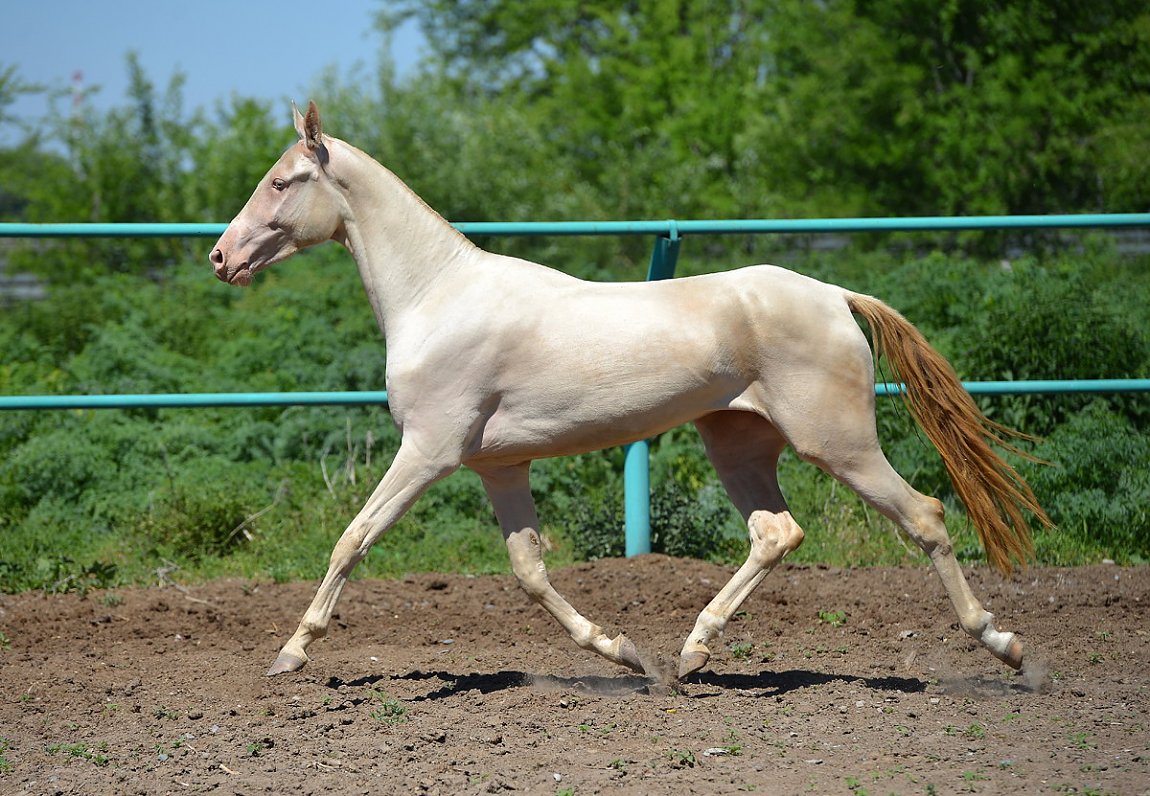
Syrlasyn (Miras - Sulgun/Saparkhan)
On his father's side, Syrlasyn comes from the so-called "line of champions", the Posman family, having the outstanding Gaigysyz as his great-grandfather, who gave the breed a new quality and raised it to the next level. Syrlasyn comes from the premiere yearling of the unfortunately deceased Miras, also a graduate of the Dacor stud. He was born in 2002 as a son of the Stavropol Salyr and the mare Mziuri from Lugovsky Konny Zawod, who for many years was the pride of the maternal herd in Dacor. This combination resulted in a valued sire, one of the most widely used in this place - Miras left behind over 20 purebred foals, some of which remained at the maternal stud, extending his line. He was also distinguished in the show ring, winning the title of Reserve Champion of Kazakhstan.
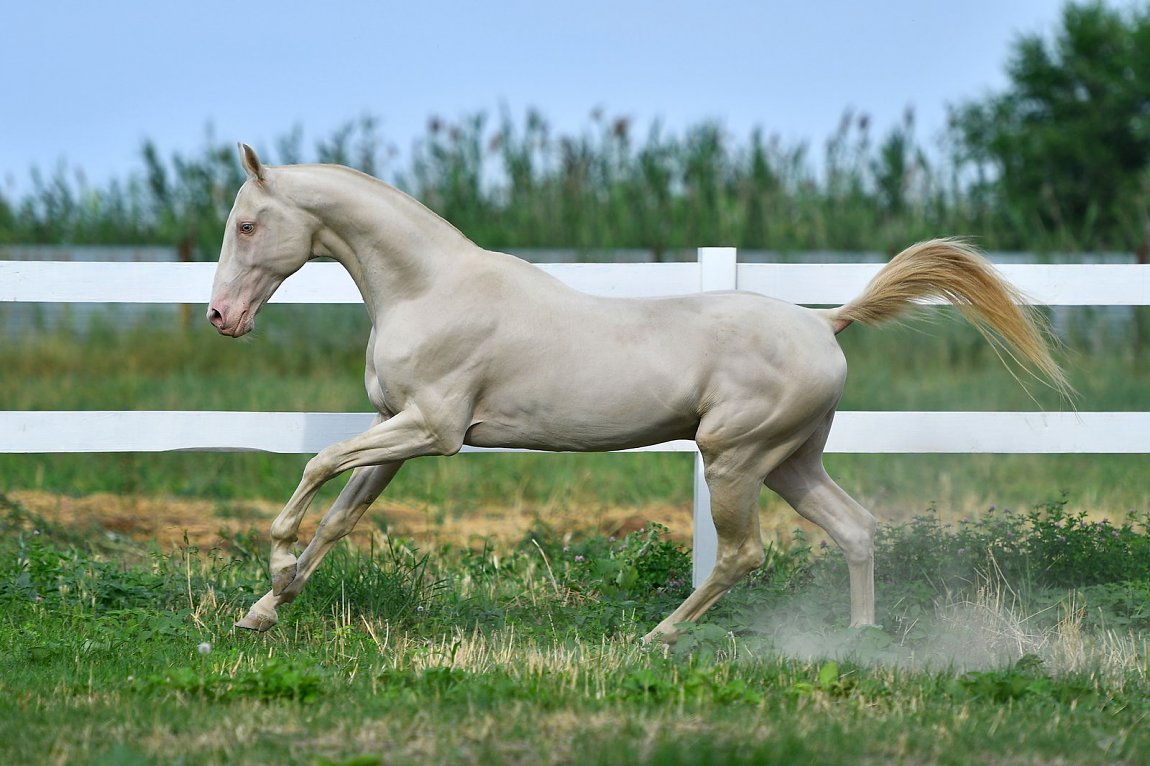
Miras (Salyr - Mziuri/Mekan)
Miras' father was born in Russia, and Alexandr Klimuk is responsible for his appearance in the world. Salyr was every breeder's dream - tall, with good bone, correct, incredibly handsome and typical, with a characteristic dark buckskin coat with golden tans, boasting an excellent pedigree. Coming from the 1997 vintage, he took part in the first World Championship, which took place in 1999 and won unanimously in the youth category. A year later he repeated this great success among older stallions and as a double World Champion was purchased by the Dacor stud to begin his breeding career there. It was not only the titles he won that influenced the fact that this stallion got a chance to pass on his genes. A horse with such pedigree is simply doomed to success. Salyr belonged to the group of the most valuable sons of Gaigysyz imported from Turkmenistan, about whom it can be safely said that his children revolutionized the face of the Akhal-Teke breed. This is a whole constellation of true breeding stars, headed by the legendary Murgab. Salyr's mother, Saniya, is a daughter of the stallion Sere mentioned at the beginning of the story, so in the case of Sagaday, we are dealing with inbreeding on the founder of his male line. Salyr left behind about 30 descendants - his sons occupied the leading stallion boxes in Dacor for years. Apart from Miras, they were: third at the Kazakhstan Championship Dallas Dacor, Kazakhstan Junior Champion Gasyr Dacor and Kazakhstan Reserve Champion Mersi Dacor. Salyr also proved himself as the father of wonderful mothers - ten of his daughters were entered into the Book and included in the breeding.
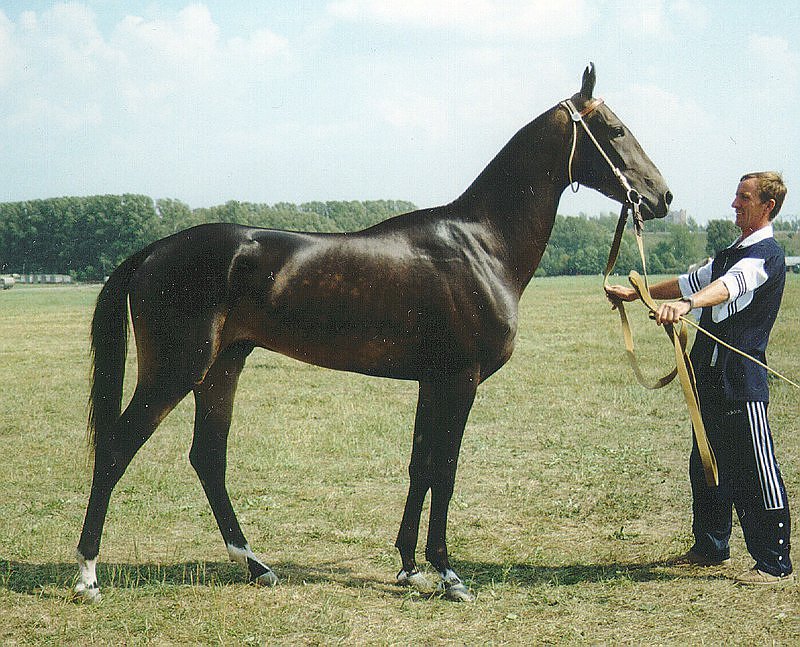
Salyr (Gaigisyz - Sania/Sere)
Salyr's Russian blood met in Miras with the Turkmen-Kazakh ancestry of his mother Mziuri, bred at the Lugovsky Horse Farm, whose foundation in the form of the Dzhambul Stud was the homeland of the most famous Akhal-Teke in history, Absent. Mziuri certainly passed on her beauty and a pinch of type to her son. She was very feminine, well-built, with a wonderful topline and a beautiful, noble head. She came from the Ashgabat-born stallion Mekan and from a daughter of the successful show jumping Khalifa, son of the outstanding Fakirpelvan.
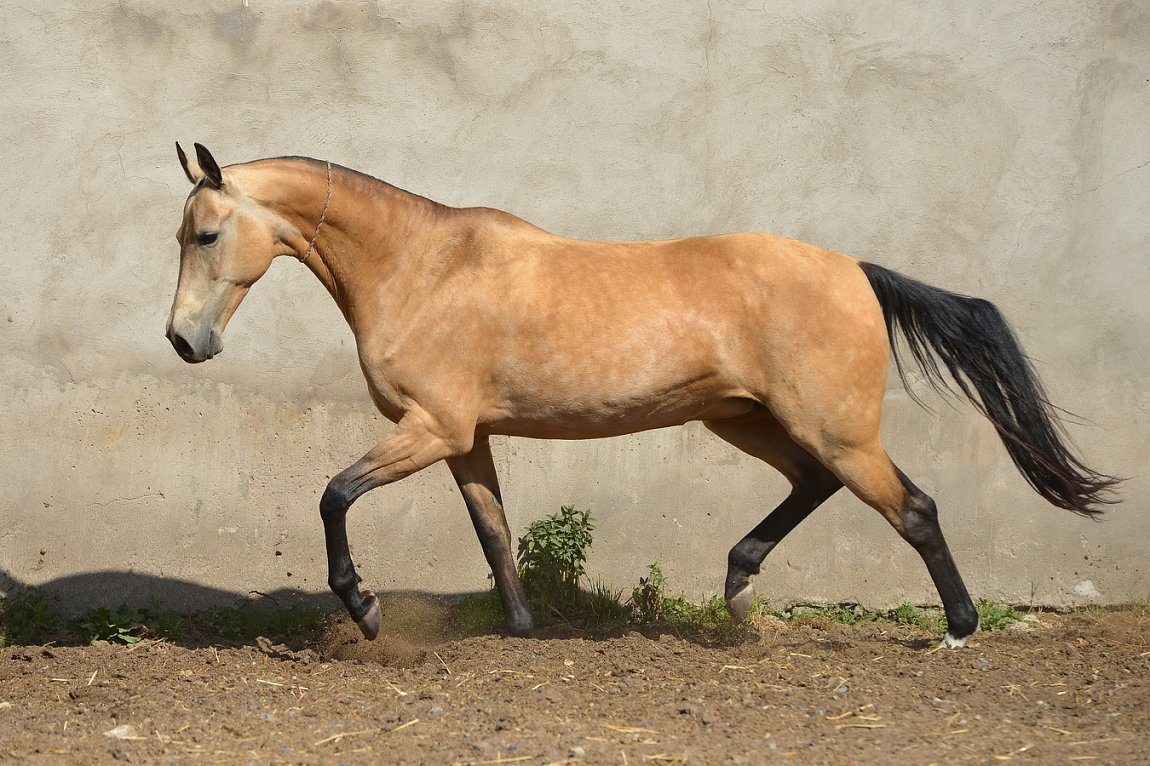
Sulgun (Saparkhan - Sovgatli/Peren)
On the female side we encounter another distinct racing accent in Sulgun, because her grandfather Peren (by Pelen) was characterized by iron health, which allowed him to start until the age of 6 and take part in 37 races. The most interesting, however, seems to be the dam line of Sulgun and her daughter Syralsyn, and therefore the family to which Sagaday himself belongs. Its founder Makh gave the Ashgabat Horse Race Kyaklik (by Kir Sakar), a valuable broodmare in Turkmenistan, who is six generations removed from Sagaday. Her full sister is Kachkyr, one of the most outstanding mares in history, thanks to whom the breed received such glories as: Angar, Polotli or the mare Kachakhchi - the dam of outstanding sires: Garagunon, Garazat, Gerden and Telekush II.
Polish Akhal-Teke horse breeding has not had the opportunity to use such interesting and valuable genes for a long time, and Sagaday Dacor can be honored to continue the legacy of its parents, grandparents and representatives of subsequent generations, who for decades have been creating the story of the purest and oldest of all breeds in the world.
text: mgr Olga Piotrowska
https://akhaltekes.blogspot.com/




